
Beyond boundaries: The legacy of Black inventions
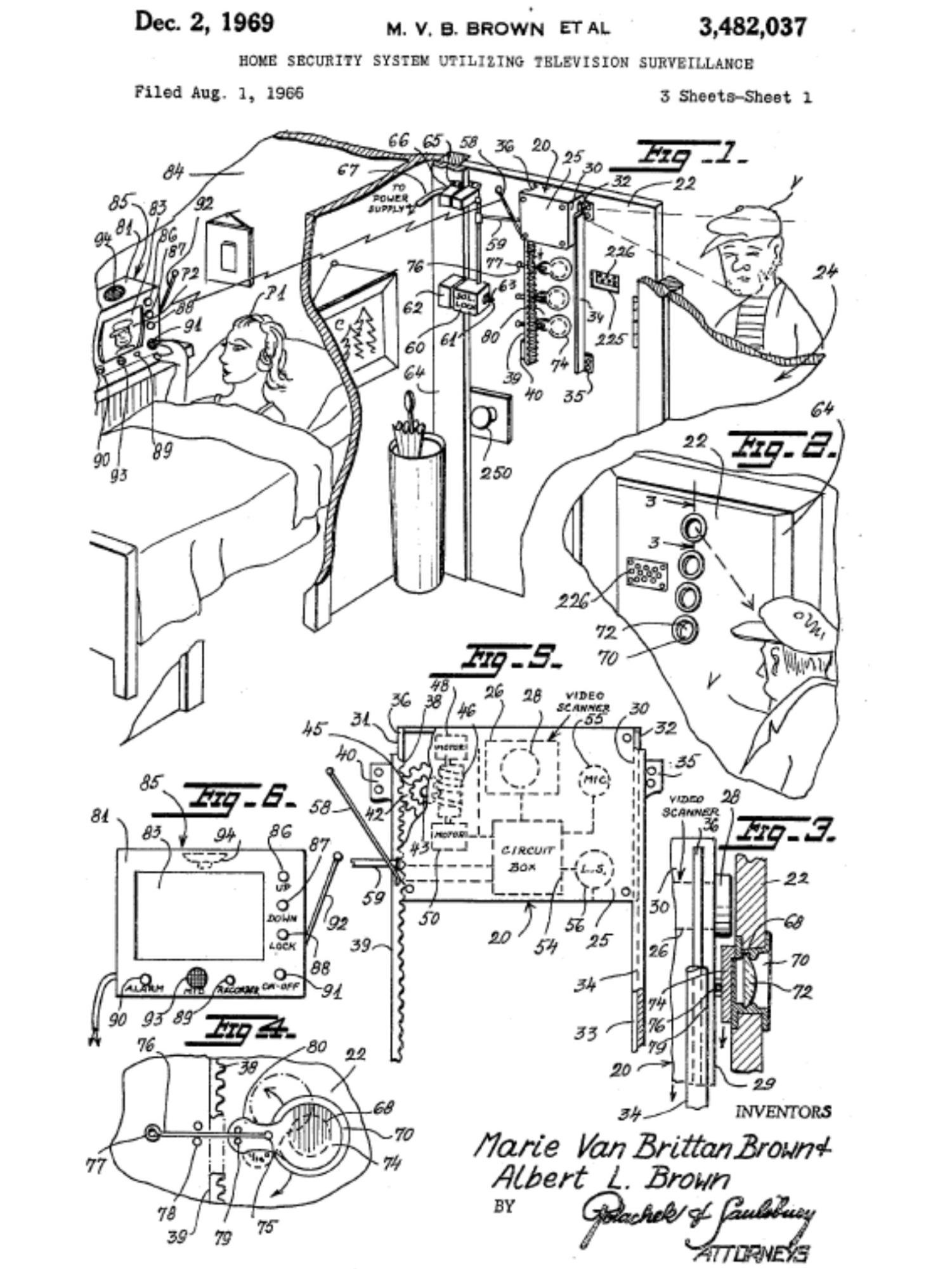
With the wave of violence that the 1960s brought, civilization required stricter forms of protection to live safely without worry. Unfortunately, Black citizens lacked protection from the police department which denied them equal justice.
Marie Van Brittan Brown heavily contributed to a safer society with her invention of the first home security system. While working as a nurse with unusual hours, Brown recognized her vulnerability as a Black woman walking home in the middle of the night. She also saw the lack of effort from police to respond to emergencies within her neighborhood.
In 1966, Brown and her husband Albert applied for a patent in hopes of distributing their new invention to help families maintain a safer lifestyle. The first home security system consisted of a motorized camera that projected video onto a monitor with four peepholes to achieve maximum coverage and visibility of a desired area.
Today, 30 million U.S. households utilize home security systems to protect themselves from possible danger in their surrounding area. Although advancements in technology improved her original system, Brown’s invention allows over 50 million households worldwide the privilege of safety against crime.
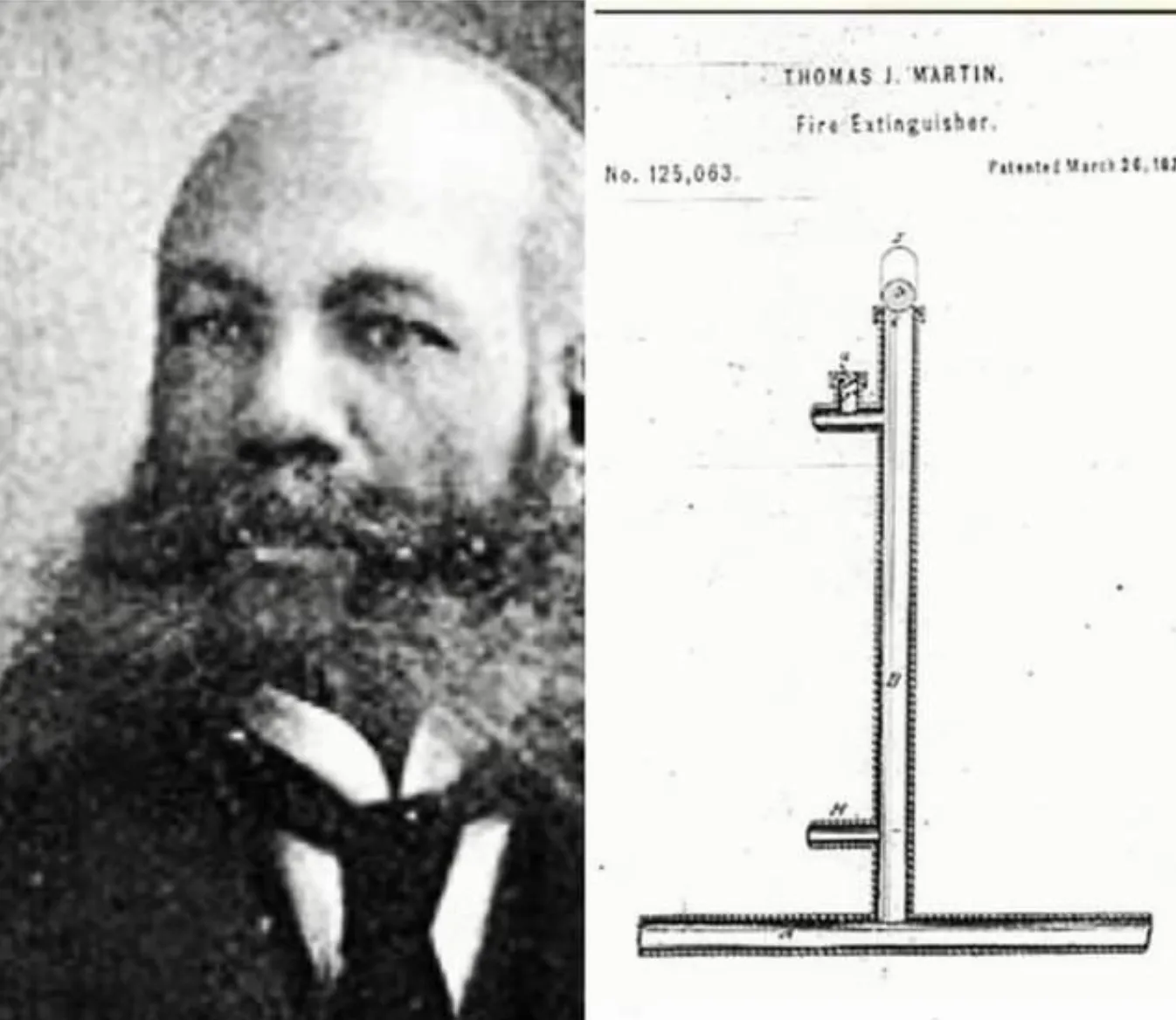
Fire: a destructive force that leaves behind a trail of ashes and smoldering ruins in a matter of seconds, and also endangers the lives of individuals caught up in its advance. In the face of the potential experience with this disaster, the ingenuity of Thoman J, Martin sought to update the earlier model of the fire extinguisher and created the fire extinguisher sprinkler system.
Born in 1842, Martin spent his early years on a farm in Shelby County, Alabama. After his service in the Civil War, he returned to his childhood state to begin a mercantile business in 1866 that continued with success until 1897. During his mercantile business, he invented a system where water could pump through a series of pipes in buildings that led to individual spinnaker heads. This contraption linked stored water from reservoirs to the pipes used to sprinkle spray water to burning surfaces and operated manually by turning a valve in the system’s building
In 1872, the US Patent Office awarded Martin a patent for his version of the fire extinguisher. His legacy lives on as his invention still stands in operation in buildings across the US since its implementation in 1874. During a decade characterized by the innovation of the telephone and the phonograph, the state of the factories during the industrial age resulted in unsafe working conditions. These conditions included the lack of fire safety measures and crowded working areas. By implementing Martin’s system, large factories could extinguish industrial fires that would limit destruction and loss of lives. Now in modern times, the US requires sprinkler systems within buildings taller than 75 feet.
“Martin’s impactful engineering is heavily integrated into the community as it’s used in almost every building and his legacy lives on by providing safety to the United States. This [origin of the invention] is something I didn’t know about so I’m sure many integral inventions that we use everyday that are by black figures aren’t recognized and this month we should try to recognize them,” magnet senior Malia Everett said.

The gas mask: an invention that has prevented smoke inhalation and saved the lives of countless people. The mask’s copious pieces ensure its users a safe and sound experience from substances such as smoke or poisonous gasses. Today, firefighters, hazardous material workers and even dentists utilize this breathing apparatus to protect their lungs from harmful substances such as smoke or radon. Though the cover has beneficially impacted numerous people, they seldom know its origin.
African American inventor Garrett Morgan began his career as a sewing machine repairman in the late 19th to early 20th century. His work at this time provided him with knowledge and experience with mechanical parts, which provided extensive help in his future. After witnessing a tragic accident one day, the inventor realized a dire need for a breathing mask to protect people from harm in smoke-filled rooms. Originally focused on easing the work of firefighters and miners, Morgan invented the “safety hood” that received a patent in 1914.
Though the hood served as a revolutionary device worldwide, racial discrimination at the time forced Morgan to hide his name behind his invention. When potential buyers learned of the inventor’s race, they refused to buy the mask, leading Morgan to cover up his identity. When he attended invention fairs, the originator would act as his assistant or even hire white people to pretend under his name. The prejudice continuously hindered the gas mask sales until an accident at Lake Erie trapped multiple men 250 feet in an underground tunnel. Morgan then used his invention to save the victims, leading the Carnegie Institution to label him a hero.

As the Northern United States ensued in their industrial era following the Civil War in the 19th century, increased production meant building expansion. The possibilities of fire hazards in workforces—especially industry-related establishments—skyrocketed. Unfortunately, society did not always take the precautions for fire-related incidents that people do now. In fact, fire escape ladders did not accompany industries and buildings until African American inventor, Quaker abolitionist and Underground Railroad contributor Joseph Winters designed an invention for the town of Chambersburg, Pennsylvania.
Less than five years after he received his patent for his wagon-mounted fire escape ladder, he received his patent for the fire escape ladder that attaches to buildings—the ladder that society utilizes today. Rather than using the short ladder attached to wagons, the longer ladder allowed people on higher floors to escape quickly in the case of a fire. His genius design boasted positive acclaim from the public due to its capabilities to save lives but lacked funding and profit as a result of racial discrimination due to his half-Black half-Shawnee Indian heritage.
Despite facing inequity in a discriminatory America, Winters succeeded in his pursuit of bettering and saving humanity. Recognizing danger and noting improvement needs, Winters’ innovation has saved the lives of thousands of people in fire-related incidents even in the present day.
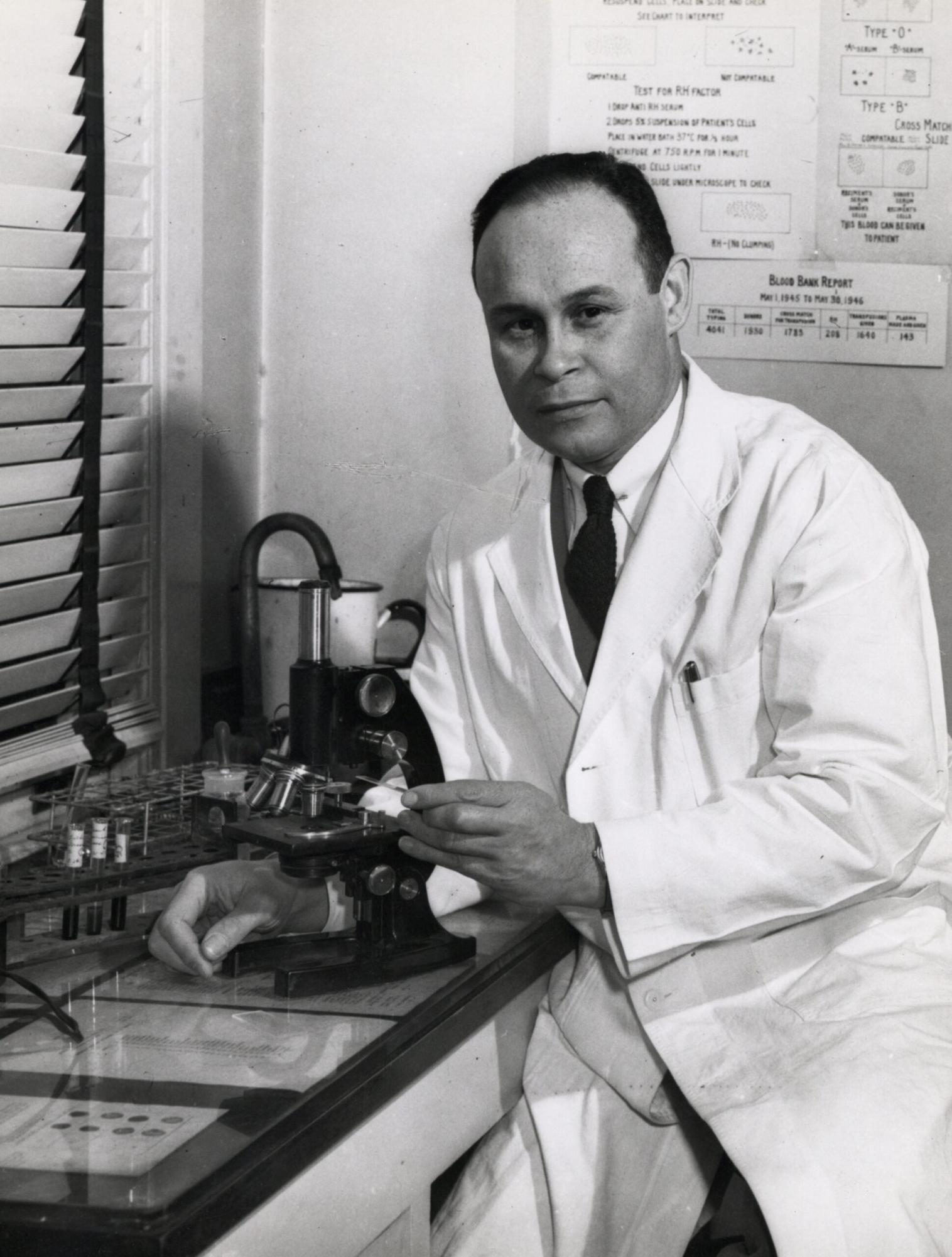
Plasma, the liquid component of blood, plays a crucial role in maintaining healthy blood pressure. However, people who endure physical trauma or deal with liver disease or blood clotting issues need plasma to help with their blood volume and boost their immunity. In certain cases, plasma stands as a better alternative for transfusions because unlike blood remaining available for certain donors, anyone can use plasma.
In the early 1900s, African American surgeon, educator and pioneering medical researcher on blood transfusions Dr. Charles Drew discovered that plasma held valuable use in transfusions. Drew attended medical school at McGill University in Montreal, Canada. There, he found his passion for blood transfusions due to its ability to save lives. After graduating from McGill University with a Doctor of Medicine and Master of Surgery degree, Drew completed graduate and postgraduate work at Columbia University, where he became the first African American to earn a medical doctorate at the institution.
Drew then developed a project that separated plasma, stored and tested it; he later shipped it to Great Britain through the American Red Cross. In January 1941, the U.S. federal government asked the National Research Council(NRC) and the Red Cross to establish a blood program; Drew soon became the Director of the new American Red Cross Blood Bank. At the time, however, the Red Cross segregated blood by race, and as a result of this discriminatory practice, Drew resigned and returned to Freedmen’s Hospital at Howard University.
“It is important that an African American invented plasma transfer because these types of outstanding accomplishments can be more impactful with some minority groups initiating it. Patients with chronic liver disease, numerous clotting factor shortages, burn, and shock are frequently transfused with plasma, being an important contribution to today’s healthcare standards. As an African American woman in STEM, this is important to me because knowing that we are improving healthcare and expanding fields in the STEM field is encouraging for someone like me,” magnet junior Betty Esayas said.
Drew not only found a way to save the lives of thousands of soldiers during World War II, but he also continues to save people’s lives daily. Nurses everyday practice plasma transfusions through the legacy of Dr. Charles Drew.

In the early days of American history, navigating the roads proved a chaotic experience as wagons, street cars, bicycles and pedestrians shared the space. However, November 20, 1993, the United States Patent Office granted Patent No. 1,475,074 to the inventive mind of African American Garrett Morgan. Born in Kentucky in 1877 to formerly enslaved parents, Morgan’s journey led him to Ohio at age 14 where he eventually evolved into a successful businessman and the founder of the renowned Cleveland Call newspaper.
While not the first traffic signal in existence, Morgan’s innovation introduced a crucial third position, enhancing the safety of crossing vehicles. In the streets of downtown Cleveland where he once witnessed the chaotic aftermath of collisions at intersections, Morgan envisioned a solution. His patented T-shaped pole with three settings included a unique warning position—similar to today’s yellow light—that provided drivers with the necessary interval to clear intersections safely.
Prosperous from his successful business ventures including a garment shop, Morgan’s invention revolutionized traffic control. He sold the rights to General Electric for $40,000, leaving a mark on transportation safety.
“I don’t think a lot of people realize how helpful traffic lights truly are. They help make the roads much more manageable and much more safe. I actually did not know the three light traffic signal was invented by a Black inventor, but it is cool that we can recognize all Black inventors during Black History Month,” senior Eliana Mbadinga said.

The sanitary belt, later known as a feminine hygiene pad, came to life in 1896 by Mary Beatrice Davidson. Women struggled with the idea of a menstrual cycle due to the lack of options to control blood flow and the restrictions it brought. At the time, the only option for sanitary methods of absorbing blood flow resided in a damp rag or napkins, which led to a bacterial infection. Shameful looks and disgust across others’ faces, when women left the house during their menstruation cycle, led to women feeling the need to undergo house arrest. Davidson and millions of other eager women grew tired of losing the ability to leave the house once a month.
Women deserve an option that provides comfort and does not leave them stuck in the house cleaning up after themselves. Davidson heard these cries for help and began crafting ideas to control bleeding and find a suitable option for women to travel with. She first came up with the idea for the belt and later patented the moisture pocket. When her idea first reached investors, they turned her away because of her race. Roughly 30 years later, the idea finally stuck with investors, and the belt gained popularity.
Despite the sanitary belt developing into a household necessity, the recognition of the inventor slowly slipped away. This invention took 30 years to become widely known due to the color of Davidson’s skin. The struggle she faced while developing the sanitary belt shows how society treated people of color, even when it came to a necessary or revolutionary idea.

Born in Providence, Rhode Island in 1857, Black inventor Philip Downing invented the Street Letter Box which remains predominantly unchanged from its original form. Years later, Downing achieved a granted patent for the Street Letter Box which essentially allowed him to continue working on the letter box so friends and families could keep in contact from all around the country. The device—frequently seen in a myriad of cities and towns—made significant changes to the United States mail system, influencing traditional ways of communication.
Downing grew up in a well-known and influential household because his father had achieved various accolades as a business owner and abolitionist during the 19th century. Before Downing invented the Street Letter Box, he developed streetcar and train switches which paved the way for the invention of the light switch known today. During this same period, Downing spent time in various cities and discovered a need to interact with family, so he solved the issue with his letterbox.
Downing dreaded the long trips to the post office when he sought to mail out a letter about his invention of the formerly known Street Letter Box, which allowed for nearby drop-offs and pick-ups for both mailers and letter carriers. He designed a metal box with four legs in which he patented to the United States Patent Office October 27, 1891. He eventually added features to keep bad weather out from damaging the mail and to keep the mail secure until mail carriers picked it up for transportation. Currently, versions of the Street Letter Box still reign throughout the 21st century including residential mailboxes, cluster mailboxes and drop boxes.

Though people everywhere use the doorknob daily, the story of its origin remains behind a closed door. Previous to today’s ubiquitous handling technology, citizens would use string contraptions to open and close doors—however, the wealthy elite would use locks and keys. Common devices also included leather straps or rim locks that date back to ancient Egypt. Nowadays, it remains difficult to fathom life without doorknobs, but when 16-year-old Osbourne Dorsey stepped onto the scene, his invention transformed lives worldwide.
As a Virginian-born African American blacksmith, Dorsey demonstrated an impressive work ethic. The self-taught inventor remained determined to create an invention that would ease the action of handling a door. Eventually, Dorsey’s persistence led him to produce a handling device constructed of cast iron, as opposed to wood. This device allowed him to receive U.S. patent #210,764 in 1878, which sparked the revolution of the doorknob. Now, people no longer rely on flimsy materials such as leather or string to hold their doors closed; the round, metallic knob provided an easier action for the countless doorways people walked through each day.
Today, the doorknob has evolved tremendously: the different designs, materials and even colors lead homeowners and decorators alike to include the handling device as an embellishing asset to any room. Little did Dorsey know that when he created the doorknob, his ideas would improve buildings internationally. Though it may seem a minute change, the doorknob remains a vital technological piece to everyday life.

Born into slavery in the early 1860s, George Washington Carver lived in Missouri on a farm that belonged to Moses Carver. In his early years, slave raiders kidnapped him and his entire family; while slaveowners traded Carver’s sister and mother to a Kentucky plantation, Moses Carver hired a neighbor to retrieve George. Despite living a life of turmoil due to his inability to contact his family, Washington Carver resorted to education as a way to escape his slaveowner’s house. Although he faced racial discrimination from college applications, he utilized his keen interests in plants and agriculture to become the first African American to earn a bachelor’s degree in science.
Even though several people associated Carver with the creation of peanut butter, people curated the food item centuries before Carter existed. However, he helped popularize the food item and discovered over 300 uses for peanuts. People used to view the peanut as a useless crop, but Carter’s innovative mind introduced the world to Worcestershire sauce and recipes for cosmetics and instant coffee. Carver also developed shaving cream and meat tenderizers along with numerous other items. The prominent agricultural scientist also created the Jesup Wagon in 1906, a mobile classroom that allowed Carver to teach sharecroppers how to grow crops.
Although Carver did not create peanut butter but merely popularized it in America, he undoubtedly changed Southern agriculture. Carver notably utilized unpopular crops such as soybeans and peanuts as a way to combat soil ruined by cotton; peanuts and soybeans could restore nitrogen to poor soil and the crops provided protein to several southerners. With his various innovations regarding peanuts and other protein-based crops, Carver helped improve the lives of poor Black sharecroppers during the 20th century. The agricultural scientist helped the Southern economy after its tumultuous loss in the American Civil War and introduced food items that people in the 21st century continue to use.
“When my teacher taught me about George Washington Carver in 6th grade, I was shocked when I learned that he didn’t make peanut butter. However, he innovated farming for centuries to come and knew the importance of education. His college education and passion for farming led him to invent ways to increase peanut production after the boll weevil devastated the American cotton crop around 1992,” magnet senior Kameron Harvey said.

Born in upstate New York, George “Crum” Speck worked as a horse jockey with his family in the 1820s. Instead of using his actual last name, Speck, George used the name Crum—his father’s horse-riding name. Crum came from a lineage of African American and Native American ancestry and mainly confided in his family of the Regis Mohawk Reservation tribe. Alongside Speck’s knack for horse jockeying, he naturally acquired an aptness for culinary art. After realizing this gift for cooking, Speck moved to Saratoga Springs, New York to adapt his culinary skills at a local restaurant: Moon’s Lake House.
From cooking meats to potatoes to side dishes, Crum found a passion for cooking and gained major prominence in his cooking abilities. With the help of his sister-in-law Catherine Weeks and restaurant owner Cary Moon, Crum accidentally created a newfound delicacy—the potato chip. According to legend, after encountering a rude customer, Crum cut the customer’s potato extremely thin and fried the thin slices until stiff. Serving the thin potatoes to the customer, Crum expected a negative reaction, but, much to his surprise, the customer enjoyed the thin crisp.
“I think that it’s important to highlight Black voices and accomplishments during BHM because it showcases how brilliant Black people are. Today, we’re generally recognized for entertainment and contributions to pop culture, but we are so much more than that. Many of us don’t even know the many inventions that our people have created that help make up life as we know it today,” magnet junior Black Student Union (BSU) president Mikiyah Spotwood said.
After finding success at Moon’s Lake House, Crum opened his restaurant, Crum’s Place, in a town near Saratoga Springs. He sold the “Saratoga Chips” at his restaurant, playing off of accidental thin-crisped delights he created at Moon’s Lake House. According to locals, those all around upstate New York visited Crum’s Place to taste the famous Saratoga Chips and to get a taste of Crum’s renowned cooking.
Years, after Crum served his deliciously salty delights, white American entrepreneur Herman Lay, found major success selling the prominent Lay’s potato chips, overtaking the lost history of Crum’s famous invention. Now, people enjoy chips as a quick snack, party treat and side to a meal every day. Although Lay took the spotlight from Crum’s story, his legacy lives on through various chip companies today.
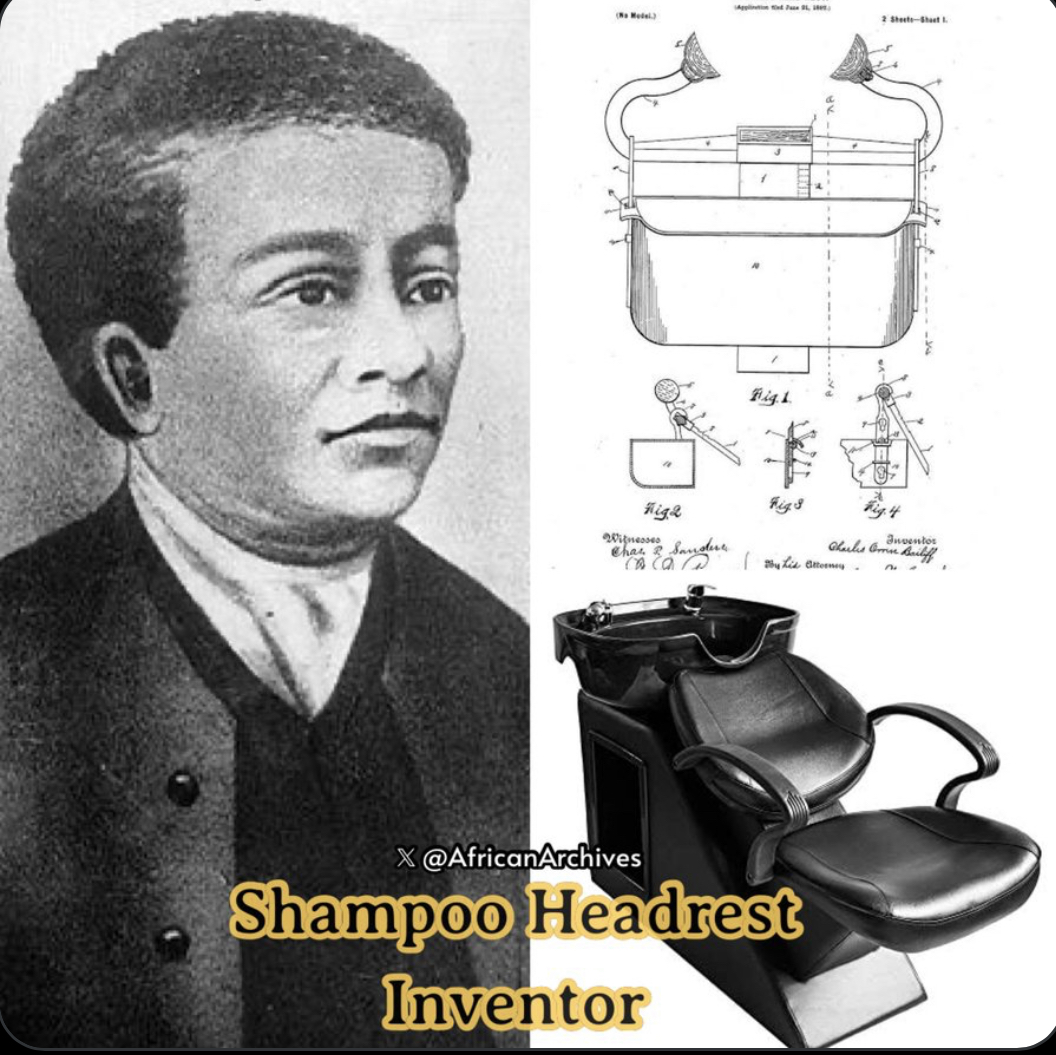
Charles Orren Bailiff, better known as C.O Bailiff, made significant contributions to the beauty industry. Bailiff found passion and took an interest in finding solutions to everyday problems. One of his most notable inventions includes the shampoo headrest which changed the hair salon experience forever.
The origin of the shampoo headrest dates back to Bailiff’s observations of the discomfort and inconvenience that both salon clients and stylists faced during hair washing. Before the headrest, clients leaned back over a sink while the stylist shampooed their hair, leading to unbelievable discomfort. Recognizing this issue, Bailiff set out to create a product that would provide a comfortable solution.
Bailiff’s shampoo headrest supported the client’s head and neck during the shampooing process, allowing them to relax and enjoy the experience. Today, the shampoo headrest stands as a common fixture in hair salons worldwide. It has become an essential tool for hairstylists, providing comfort for the client and ease for the hairdresser. Bailiff’s contribution to the beauty industry continues to receive celebration and appreciation from stylists and clients.
“I remember bending over and getting my hair washed; the [shampoo] headrest was invented then, but I remember the discomfort bending over brought me. This product does exactly what it was designed to do. I love it,” senior Amyra Mitchell said
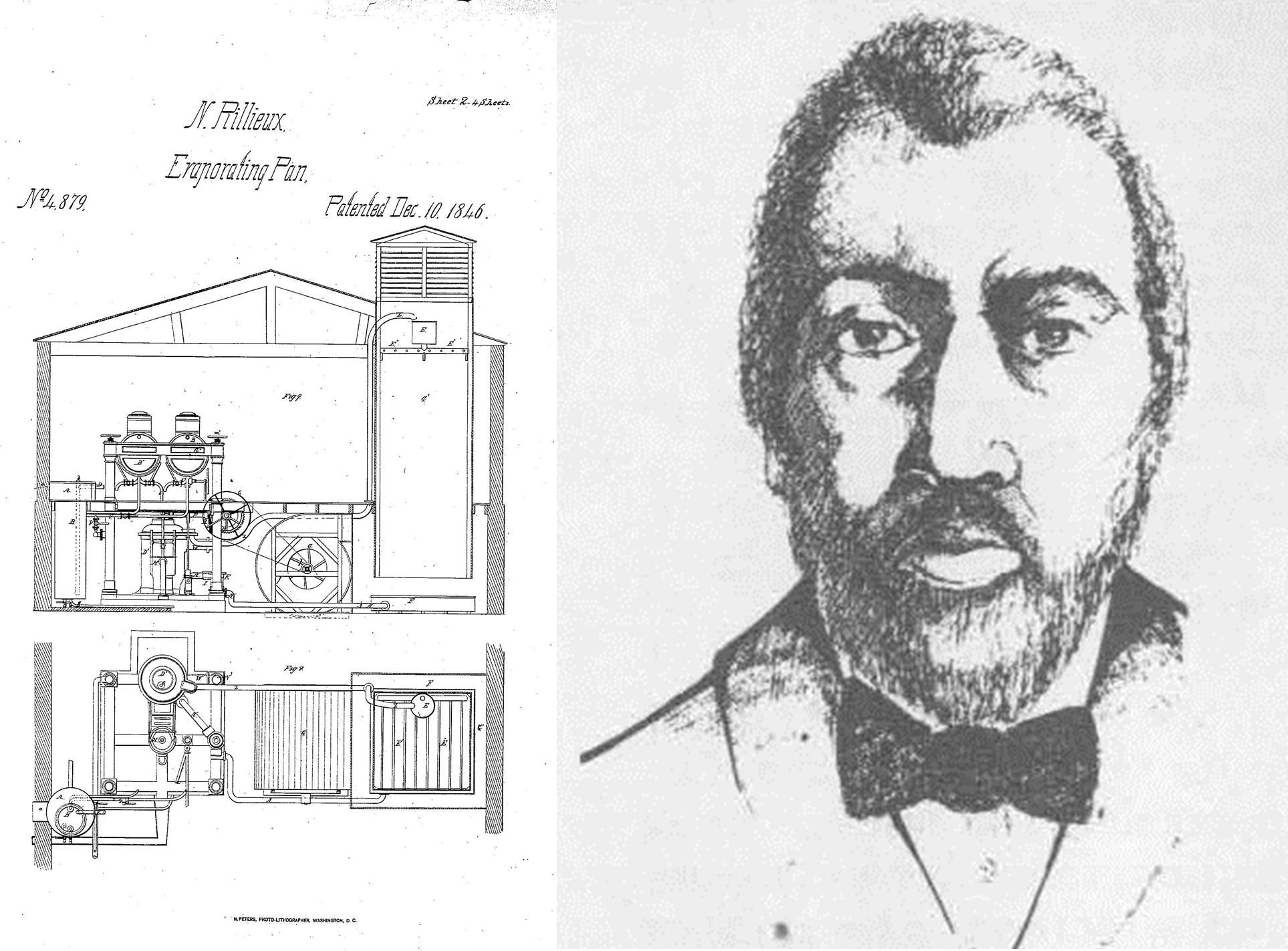
From coffee to cupcakes to juices, sugar helps a vast array of treats satisfy consumers. While the soluble carbohydrate serves to sweeten up the lives of those who eat it, the process of harvesting sugar proves tedious. According to The Sugar Association, the operation of converting sugarcane involves several types of machinery, such as rotating arms, conveyor belts and sugar refineries. Although sugar manufacturing in the modern day takes a hefty load of time, the process used to require heavier labor with decreased ease. Fortunately for sugar producers of the 19th century, inventor Norbert Rillieux relieved that burden through the creation of the multiple effect evaporator under vacuum.
Born the son of a French engineer and an enslaved woman, Rillieux experienced a unique set of education opportunities growing up. He obtained knowledge of steam engines and the steam economy, and eventually applied it at his father’s sugarcane plantation. After observing the slow production rate of sugarcane, Rillieux developed a mechanism that utilized a vacuum chamber, manipulated the boiling point of liquid and evaporated the juice into another part of the vacuum. The initial iterations of his invention did not attain success, however, once he further developed the mechanism, he officially received a patent for his creation in 1843. Four years later, the multiple-effect evaporator spread to at least ten different refineries, and increased the efficiency of producing sugar. Eventually, the invention spread to countries such as Cuba, Egypt and France.
Until the mid-1850s, Rillieux witnessed the zenith of his success for his instrumental invention. Despite this, he still received racially-charged backlash from consumers due to his biracial identity. He retired to France and lived there until his death in 1894. Throughout his innovative career, Rillieux essentially revolutionized the sugar production industry of the 1800s, and his invention’s legacy still lives on today. His astute understanding of both chemical engineering and the manipulation of latent heat stands as a testament to the revolutionary nature of Rilliex’s work.
“I think it’s important to understand the Black history behind many modern-day technologies. It empowers others to overcome the obstacles they may have in life to achieve greatness. It’s also important to talk about the successes of Black figures in history because it allows for the representation and application of a positive mindset for today’s youth,” magnet junior Laila Sain said.

From the alluring city of Cincinnati, Ohio, African American innovator Willis Johnson left an indelible mark on culinary history with his patent and improvements on the egg beater February 5, 1884. Breaking away from convention, Johnson’s invention, initially conceived as a versatile mixing machine, ushered a transformative effect on baking.
Unlike the labor-intensive kitchen tools of its time, Johnson’s egg beater stood out as a double-acting marvel with two separate chambers, distinguishing itself from other culinary innovations. This clever design allowed bakers to beat batter in one section of the beater simultaneously while whisking eggs in another. Johnson’s patent abstract unveils the meticulous details, featuring a mainframe with a driving wheel and pinion, complemented by detachable trays or racks for holding beater shafts armed with blades.
In a crucial moment for culinary history, Johnson’s invention not only signaled a shift from traditional hand-cranking to an efficient method but also served as the precursor to the electric mixers that would follow. His egg beater, initially designed as a versatile mixing machine, exemplified the way innovation could transcend kitchen boundaries.

Throughout history, the medical field has advanced to adapt to modern health defects and issues in need of solving. African American inventor and engineer, Otis Frank Boykin paved the way for his noteworthy pacemaker with a patent he filed for his idea of a wire precision resistor in 1959. Boykin desired to find a preventative measure for heart failure given that his mother passed from the condition when he turned one. With his desire to save lives, 31 years later, Boykin designed the resistor to send electrical currents to help regulate a heartbeat which influenced the pacemaker control unit.
Two years following, Boykin earned a second patent for a uniquely inexpensive electric resistor which influenced International Business Machines Corporation(IBM) to use his ideas in their computers. The United States military also began using his resistor designs to build guided missiles. Boykin’s resistors continued to gain popularity as he eventually earned 12 U.S. patents related to resistors and minuscule electronic units over the course of his career.
“The Pacemaker was able to save a relative of mine’s life because it helps control his heart rate. After a severe heart attack, it helped the left side of his heart, which was severely damaged, to actively pump blood through his heart which he could not do on his own. Without this invention, he would not be able to live the healthy, active lifestyle that he is getting to now,” NC parent Maria Blanco said.
The Pacemaker now obtains long-lasting effects, achieves low manufacturing costs and has allowed for greater improvement for patients aftercare. Boykins technology paved the way for the 27 patent electrical units and the resistor which would become part of the Pacemaker control unit. Without the instrumental ideas of Boykin’s work, Pacemakers would not have achieved the same level of pacing technology throughout the advancing medical field.

Humans have carried their children in creative ways since the beginning of society. In car seats or cradleboards, parents take their children along with them as they continue to live their lives. The baby carriage became a major invention necessary to this parental mobility.
Although baby carriages have existed since at least 1733, they could not work as they do today without the innovations of William H. Richardson, an African American inventor who patented a type of baby carriage in 1889 that allowed the bassinet to face the person pushing it. His carriage also permitted increased control of turns by allowing each wheel to move individually.
“I think the innovation of the baby carriage was very helpful for mothers who would be too tired to carry their kids. The benefits of the easier and closer turning would be the fact that it allows for fast movement for people. It is interesting to see the changes made to the world by African Americans,” magnet sophomore Deborah Abraham said.
Richardson’s engineering that created this carriage stands as a testament to his inventiveness. The way parents transport their children has developed exponentially since 1889, but the strides that he took to make it safer will eternally shine through. Whether the stroller came from Amazon or an antique shop, the reversible capabilities and better steering all track back to Richardson.
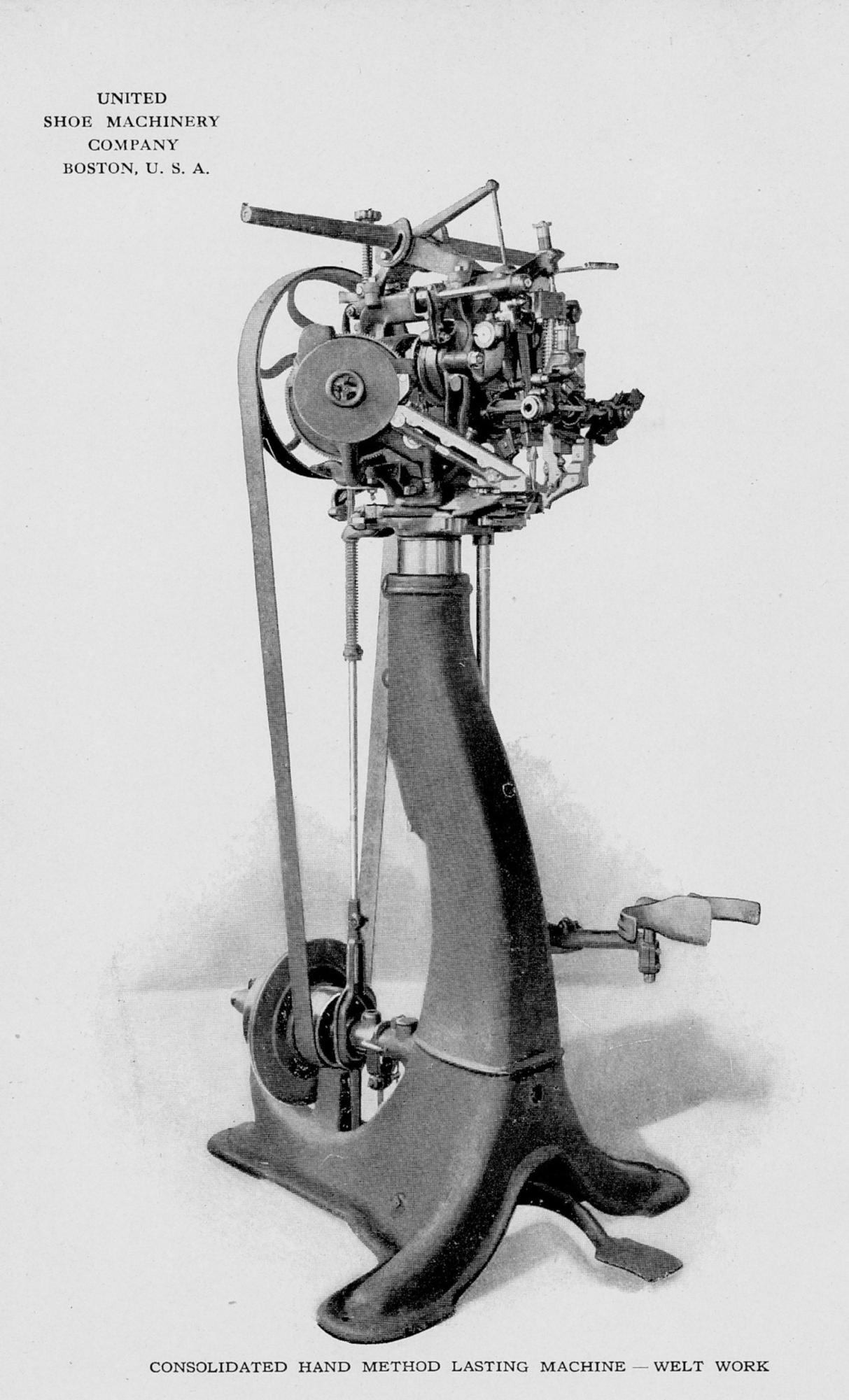
In the early history of shoe making, the binding of the sole and the upper would consume tedious and methodical hours of work by shoemakers. The technique used to lace the sole to the shoe’s body— known as lasting— requires precision and patience no matter the equipment. Surinamese shoemaker Jan Matzeliger ran into issues with lasting shoes when he aspired to produce the shoes with greater efficiency.
Prior to 1883, the year Matzeliger’s shoe-lasting machine received a patent, skilled artisans could last up to 50 pairs of shoes per day, which entailed stretching the leather by hand and maintaining enough tension for the shoe to retain its shape while lasting. Matzeliger created several prototypes made from cigar boxes and eventually created a product that completed up to 700 pairs of shoes in a day. The machine contained such complex details and parts that patent examiners could not fully understand how the machine operated until watching Matzeliger use it.
“Shoes do so much for us… for me and for other people. It isn’t just about style, these shoes hold weight to us [the black community]. I mean if you look at Michael Jordan, when he started playing in the [Jordan] ones, everyone wanted a pair. He was a huge inspiration to the black community,” junior Jaiden Nichols said.
Today, wide-scale shoe production has allowed communities to connect through footwear. Matzeliger opened a pathway for the shoe industry to become productive, efficient and creative, and centuries later, shoes have become an integral part of the culture, including in the Black community.
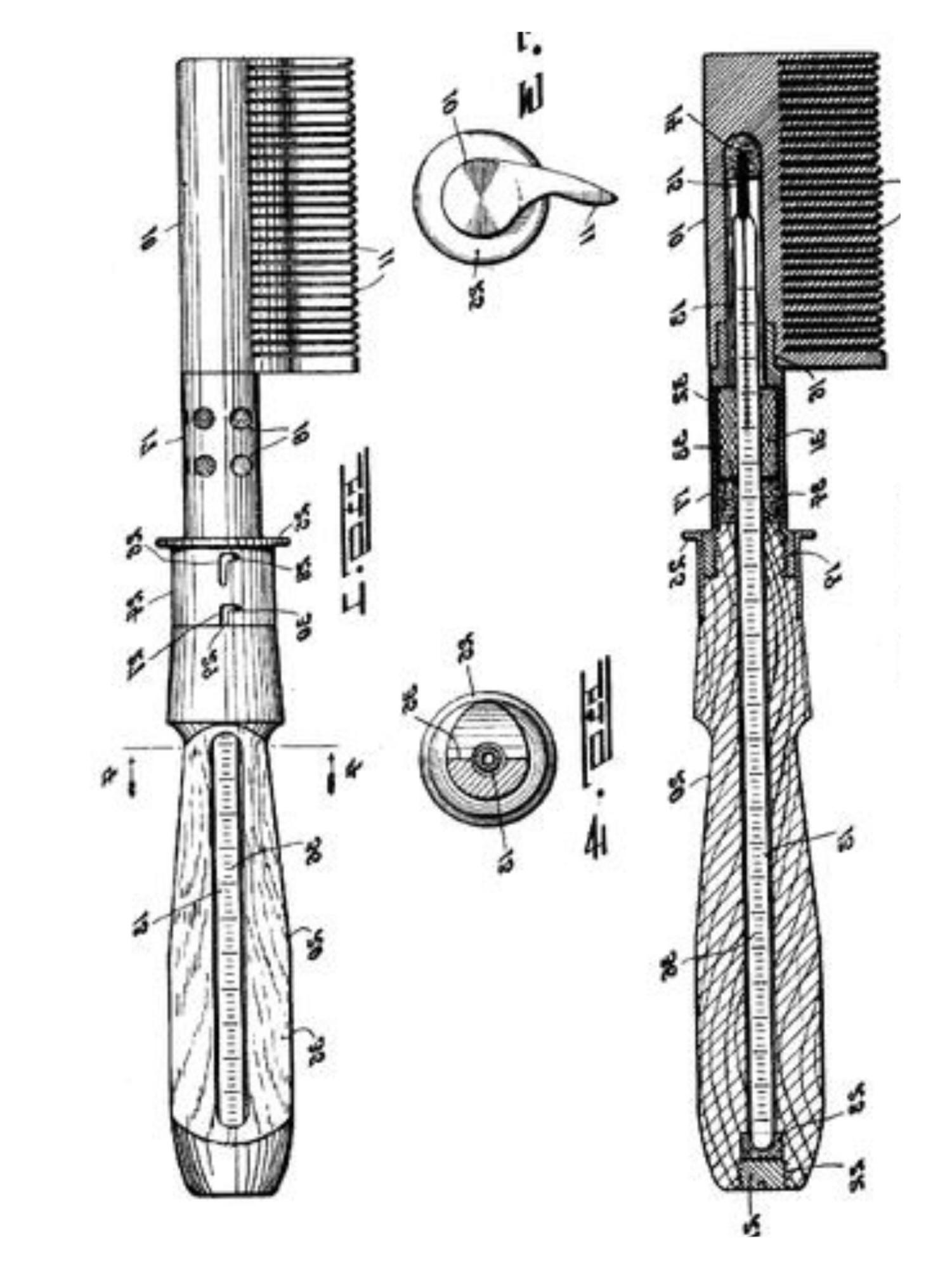
Experts say hair type 4C remains the most difficult to manage compared to 1A hair. People with 4C hair textures deal with low porosity, shrinkage, product buildup and other high-maintenance hair problems. Credited as the first self-made American entrepreneur, Madame C.J. Walker created the first hot comb attachment to straighten and smooth moderate or coarse hair. Born in 1867 to former slaves, Walker faced numerous challenges throughout her life, but she overcame these challenges and changed the hair care industry.
When Black people’s hair did not receive proper attention in the 1900s, Black women wore their hair natural or pulled it back due to the depravity of hair products for their hair type. After losing a significant amount of hair due to her scalp problems, Walker worked under Annie Malone to help create a business to improve and style Black women’s hair.
Walker’s straightening comb provided women with a tool to transform their hair and feel more confident in their appearance. The straightening comb quickly gained popularity and Walker’s hair care products increased in demand. The success of her business challenged the prevailing beauty standards of the time and gave Black women a place within the standard. Today, the straightening comb contributes to self-expression for women.
The Poro brand and college excelled within its first year in business. The brand sold numerous hair care products for those trying to improve and revive their beautiful yet underappreciated hair. The famous Poro college served as a cosmetology school for mainly Black women who learned how to style and treat hair as well as learn to perform manicures for anyone interested.
After attending Poro College, Walker added to the pressing comb, originally created by Marcel Grateau, a hot comb that resulted in a smoother hair texture with less heat damage. This addition improved expectations and continues to empower Black women who wish to achieve straightened hair.
“I remember the first time I used a hot comb. I was pretty young but obviously since I had a lot of hair, it was always difficult to style it. For a middle school dance, I really wanted my hair straightened so my mom bought me a hot comb and I loved it. I’ve learned to embrace my natural hair more since then but I’m still grateful for the hot comb whenever I need it,” junior Alyiah Euwing said.
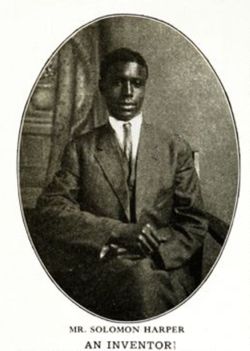
Curlers have remained a symbol of the stylish hairstyles coiled on one’s head. As an instrumental part of the beauty industry, hair stylists and influencers who wear their spiraled, bouncy curls carry the genius of an inventor whose creations allow the curls on their head to last throughout the day. Black inventor Solomon Harper created the first electrically heated hair rollers that allowed individuals to keep up with the hottest curly hairstyles that continue to trend.
Born in 1893 in Poplar Grove, Arkansas, Harper sought to create inventions that provided efficiency and allowed for stylish hairstyles to persist from the natural obstacles that forced them to fall. Trained as an electrical engineer, he sought to implement the use of electricity to create a heated roller for users to acquire the desired bouncy hair. Applying heat to the mold allows physical hair bonds to become rearranged in one’s twisted coils. In 1930, he received a patent for his first design of electric thermal hair rollers. His genius continued as he patented an updated design in 1953 to improve the ability to create lasting curls.
Harper obtained his patent during the Great Depression— a time when people looked to Hollywood as a distraction. The defining aspects of 1930s glamorous Hollywood included tight, elegant curls that became a symbol of femininity. Harper’s hot invention arrived on the scene, creating the iconic hairstyles a part of the glitz and glamor era. Along with the hair rollers, Harper also invented other heated hair tools to assist individuals in the beauty industry, such as the heated hair curler and comb. As the textured waves continue to remain in style, Harper’s legacy lives on through his electric technology to heat hair tools. Although one can find a variation of his inventions in salons, beauty stores and in a scene of a bathroom “Get ready with me”, Harper struggled to gain compensation and rights for his inventions and experienced deprivation of billions of dollars worth of his inventions.
“I believe that Solomon Harper deserves all the credit and recognition for the tool as he did invent it and should be compensated for his industry-changing invention and it’s really sad that during his lifetime he didn’t receive it. Curly hairstyles have been popularized for so long and his invention definitely helped create the trendy hairstyles seen throughout the decades,” magnet senior Kortlyn Riley said.
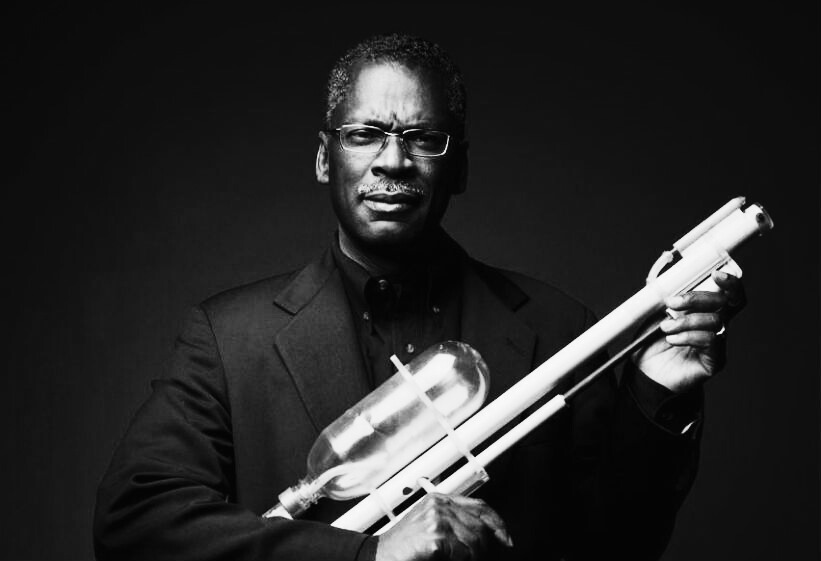
Soaking in the sun’s rays on a hot summer afternoon, the neighborhood’s children make long-lasting core memories with outdoor games. Each generation garners their “go-to” game that they played outside with the children they knew, and these games likely involved The Power Drencher—more famously known as the Super Soaker.
Released in 1989 and invented by African American scientist and inventor Lonnie Johnson, the Super Soaker serves as a staple in outdoor childhood games. While working on his Galileo assignment from the National Aeronautics and Space Administration(NASA), an unexpected stream of water shot across the room. Johnson’s ingenious, brilliant and gifted soul turned an accident into an invention that would eventually transform the water gun world. Although he spent years carefully designing the Super Soaker and felt confident in his phenomenal invention, he encountered a financial hardship: he needed $200,000 to sell his product in the stores. Not giving up on his creation, he searched for an investor for seven years until he found a shareholder.
Since 1989, the Super Soaker has earned over $1 billion and has engraved itself in the memories of several generations of youth. Although Johnson turned 74 in October, his inspiring and inventing spirit has not ceased—currently, Johnson retains his establishment, Johnson Research and Development, and pursues working on projects for NASA. Curating an invention off of a simple accident, Johnson demonstrates excellence and inspires future generations of innovative minorities to utilize their creative talents and pursue ambition in the face of adversity.
“I remember my cousins and I used to play with the super soaker during the summer when I lived in Alabama. It’s important that a person of color receives credit for this revolutionary toy because it impacted a lot of people’s childhoods. When I go to the pool, I still use it,” senior Thaison Jones said.

In 2022, the Recording Industry Association of America reported that for the first time in over three decades, vinyls outsold CDs and continued to increase in popularity. Although the purchases of vinyl and record players have occurred since the early 21st century, people born between 1997 and 2012 have bought LP records. People buy physical copies of their favorite albums and place 12-inch circular disks under the arms of record players. Over a century ago, Joseph Dickinson would curate an arm for the record player’s stylus. Not only would he revolutionize vinyl culture, but he would also impact the piano industry in the 20th century.
“Vinyls have increased in popularity because I think people want more tangible music they can physically own and more people want to support their favorite artists directly. Throughout history, Black musicians have made significant contributions to the development of music technology, often without receiving proper recognition,” magnet senior Vania Djomah said.
Born in Canada in 1855, Dickinson would later migrate to Detroit, Michigan in 1870 to pursue his musical interests. As he ventured into an unknown country with hopes of fulfilling the American Dream, he joined one of the largest corporations of musical instruments at the time: Clough and Warren Organ Company. Dickinson began designing his own versions of organ pianos, and one of his designs allowed him to win a prize at the Centennial Exposition. Thanks to his innovative mind, he became popular among musicians and major customers quickly hired him to build organs.
Along with his impact on the way people listen to music records, Dickinson also received a patent for the player piano in 1912. Although he did not create the first piano that could play by itself, his mechanisms resulted in improvements in the way that player pianos functioned. Dickinson also invented a roller mechanism for the player piano— a device that allowed him to play sheet music in forward or reverse mode. Dickinson undoubtedly impacted the way that piano players perform with their beloved instruments, and people should think about his creativity as the arm of their record players play their favorite albums.
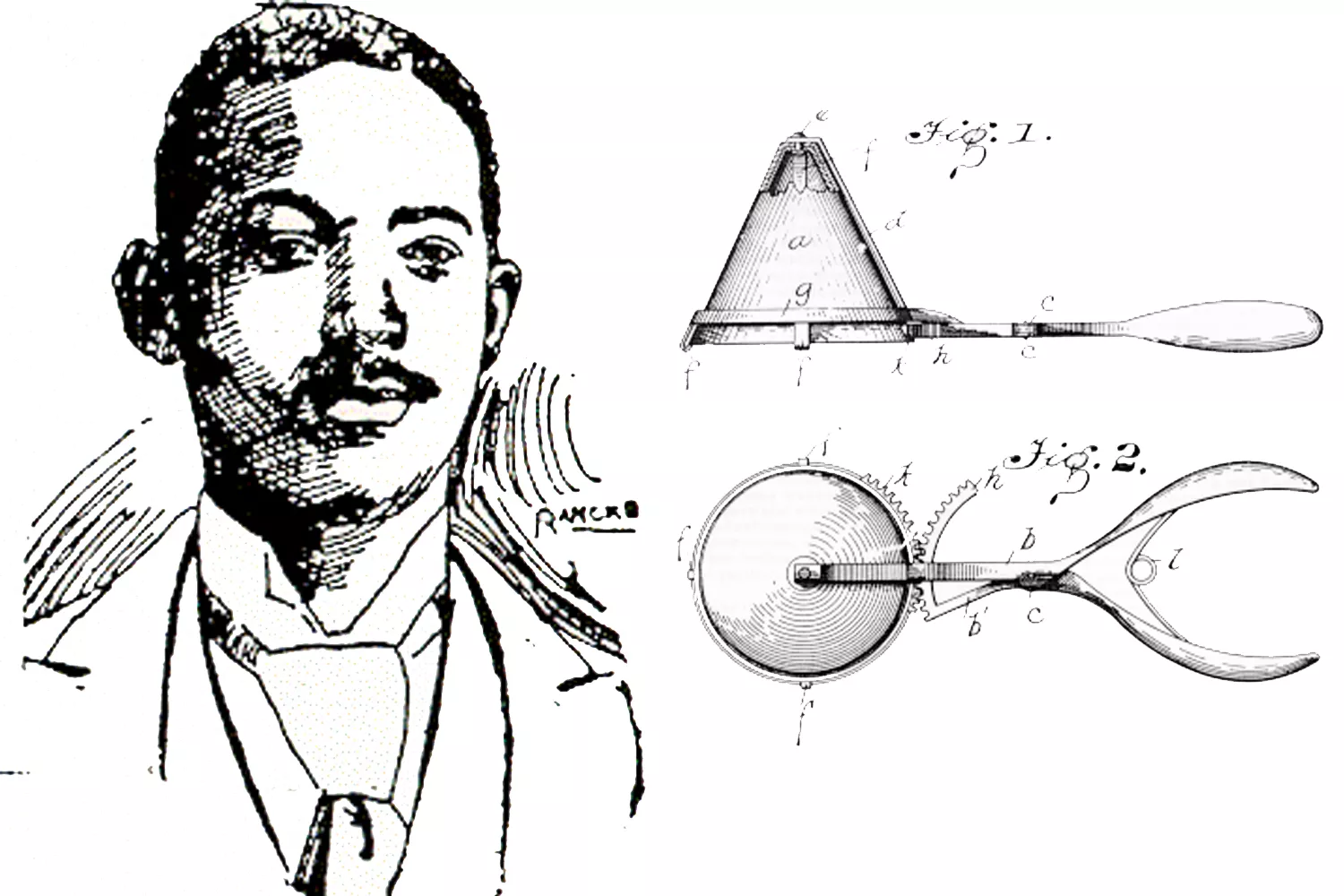
From chain parlors such as Menchies to local establishments such as Scoops, the NC community harbors first–hand experience with the sweet joys of ice cream. Despite the immense adoration the treat receives, one aspect flies under the radar of recognition by connoisseurs— the ice cream mold. This novel tool, created by Black inventor and businessman Alfred Cralle, allowed for the distribution of ice cream to occur in a swift manner. Despite the lucrative allure this invention may emit, however, Cralle never received a dime for his innovation.
From his youth, Cralle took an interest in mechanics, and he studied the field further at the Wayland Seminary of the National Theological Institute in Washington, D.C.. During his stint as a pharmacy worker in Pennsylvania, Cralle brainstormed ways in which the dispensation of ice cream from the server’s spoon to the customer’s cones could transpire less awkwardly. The early iterations of the ice cream mold and scooper heavily reflect its contemporary iterations, with the head of the tool sporting a triangular scooper as opposed to the cup form it harbors today. By 1896, Cralle’s invention became a historically patented reality; By that following year, consumers eagerly utilized his successful creation, and his efficient innovation received raving acclaim from his local Pennsylvania newspaper “The Pittsburgh Press.”
“His [Cralle’s] invention made it so convenient to scoop ice cream. It’s difficult to scoop with a regular spoon, and the scoop is so much easier to dip in water and then into ice cream. The curvatures make the hard work easier. I just wonder what we’d be using to scoop ice cream without it,” senior Imani Wilson said.
Although his invention helped drastically improve the quality of ice cream distribution, Cralle never received any profit or celebrity from the creation of the ice cream scoop. Before his tragic death in 1920, Cralle remained relatively unacknowledged in the realm of entrepreneurship for his landmark tool. While he did not receive any financial gain for the ice cream mold and scoop during his lifetime, the legacy of Cralle’s groundbreaking invention lives on in every ice cream parlor, lounge and store.
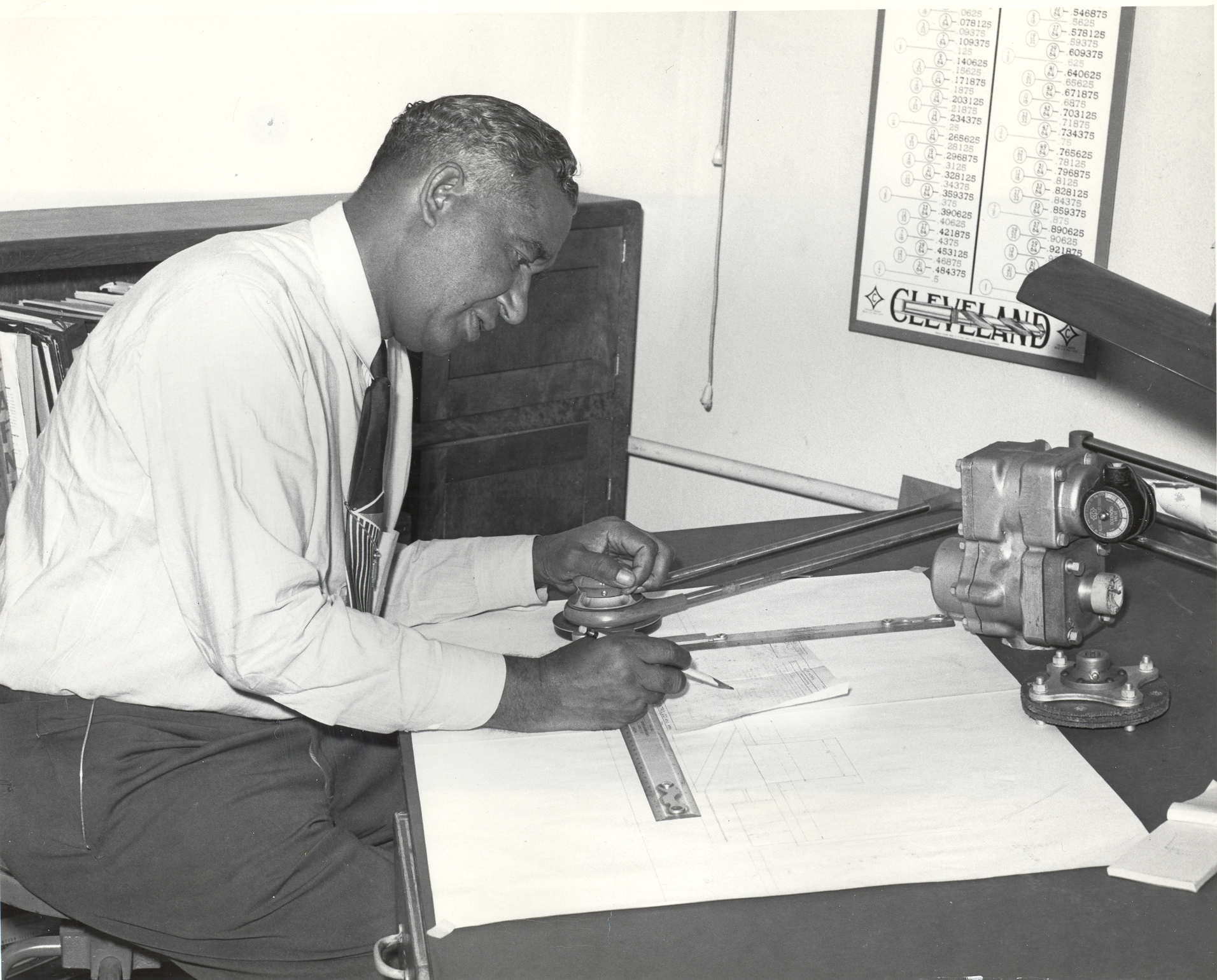
Without the invention of the refrigerator, food preservation technology would remain far below par. Furthermore, without this appliance, mass food storage in grocery stores, ice cream trucks and most of the refrigerators in the average home could not exist or would exist in a rudimentary light. African American Frederick McKinley Jones came into the world in Kentucky in 1893, destined to a difficult but ingenious life as a pioneer in refrigeration technology.
The acute inventor created and patented the first portable air-cooling unit, a major step toward modern conveniences such as the ice cream truck. He also bears the responsibility for the trucks that take perishable foods across the country, feeding the world. Jones also invented an air-conditioning unit for military field hospitals, keeping innumerable people comfortable inside. These and the more than 20 other patented inventions only represent a minute example of Jones’ indisputable mark on the world.
Jones’s innovations in refrigeration paved the way for the modern distribution of food. With every ice cream bought from a truck or apple purchased from a grocery store, Jones takes credit. His inventions allowed a new era of agriculture and food distribution to open up that effectively feeds the modern world.

Opening the doors to a safe and accessible method of transportation, Black inventor Alexander Miles created automatically opening and closing elevator doors. Born in Circleville, Ohio, Miles successfully worked as a barber in Duluth, Minnesota, becoming the first Black member of the Duluth Chamber of Commerce. Motivated by a situation where Miles and his youngest daughter rode in an elevator where the shaft door did not close, protecting elevator passengers became his goal.
October 11, 1887, Miles patented his innovative advancement to the elevator. Because passenger elevators stood as a relatively new idea, they arrived with numerous risks and speculation if necessary. From the beginning of elevators, elevator shaft doors required manual operation to allow passengers on and off each floor. Because of this, falling down the shaft to one’s death became a high risk and left the attractions untrustworthy. Using a flexible traction belt, Miles automated the doors through a series of simple machines, allowing the doors to open and close upon reaching a floor destination.
Alongside revolutionizing the future of metropolises and the standard features of elevators in modern designs, Miles devoted a portion of his life to improving the lives of African Americans across the U.S. through his life insurance company. As one of the wealthiest Black inventors, Miles also received a feature in the National Inventors Hall of Fame in 2007. Returning to work as a barber, Miles shaped the safety of common buildings today such as hotels, hospitals and schools.
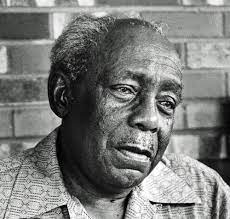
Today, people can achieve a glossy, clean look on their wood, marble or tile thanks to Thomas W. Stewart‘s patenting a convenient mop June 11, 1893. The word mop traces back to the late 15th century when people spelled it like “mappe” in old English. The old mops typically consisted of bundles of rags or coarse yarns attached to a wooden pole.
Stewart, born in Kalamazoo, Michigan, patented a new mop that makes people’s lives easier. He first designed a mop head that people could detach from the wooden pole so they could clean or discard it. He then designed a lever that would wring water from the head so people could avoid involving their hands. Companies such as O-Cedar, one of the most popular mops in 2024, utilized Stewart’s design in their EasyWring mop.
Stewart also received a patent in 1883 for a station and street indicator, and he invented a metal binding machine in 1893. Stewart stands as an innovative African American who revolutionized cleaning with his ergonomic mop design. Because of him, people today can spend less time mopping and more time enjoying shiny and clean floors.
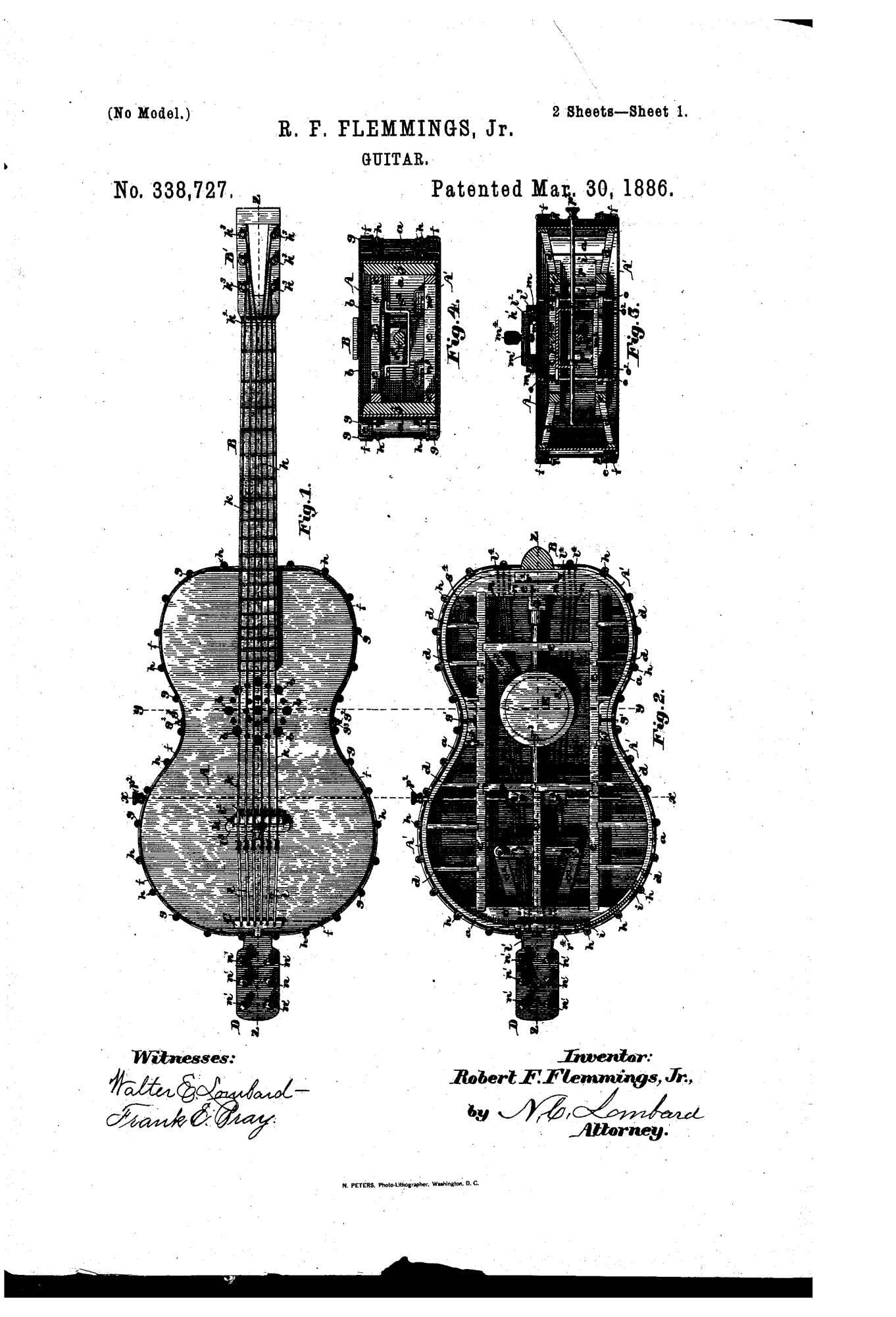
For centuries, humans have enjoyed the melodies from string instruments, especially the guitar. While occasionally associated with inventing the modern acoustic guitar, African American inventor Robert F. Flemming Jr. created a rather unknown yet monumental innovation in modern music: the euphonica. Born a free man in 1839 in Baltimore, Maryland, Flemming would eventually serve in the United States Navy. As a Union sailor in the Civil War, Flemming became the first person in history to witness the sinking of a ship by a submarine. After his service, Flemming moved to Massachusetts, where he would open a music shop and express his passion for the arts by providing music lessons.
At the time of his music shop’s opening, classical acoustic guitars rose as the premier choice for guitarists. Flemming aspired to create a string instrument that let off a louder resonance than that of its Spanish predecessor— the classical guitar. In 1886, Flemming received a United States patent for the Euphonica. While maintaining an overall shape and style to the guitar, the revolutionary product changed how people could hear string music. While he did not invent the guitar, Flemming reinvented music.
The exact implications of Flemming’s invention remain unclear, and his impact in the music industry became quite fuzzy. Regardless, the addition of elements such as metal pegs to his instrument remains a unique aspect of modern guitars which stands against earlier models.
The acoustic guitars heard today produce a crisp reverberance unparalleled by any past string instruments. While the euphonica never grew as widely available as the acoustic guitar, Flemming’s desire to improve the sound quality of string instruments possibly inspired the future of the guitar. Euphonicas no longer sell in the market today, but Flemming’s love for music and innovation played a pivotal role in the direction of modern guitarists.
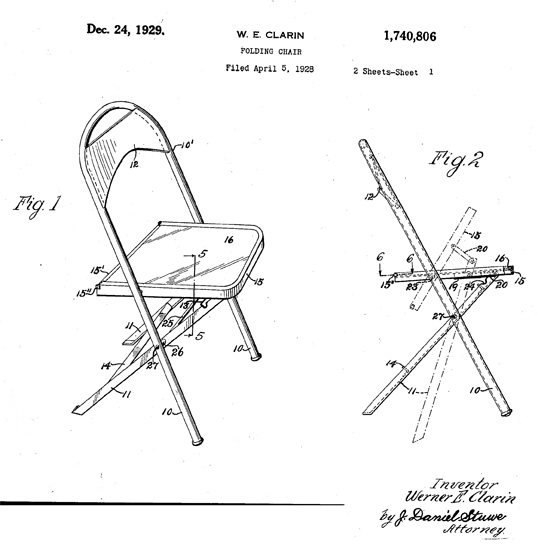
The foldable chair —existing in every closet and garage and easily providing comfort at parades, camping, and other outdoor events—originally came to the public in 1855 when John Cram patented the idea. The early designs of the chair typically appeared in an X-shaped concept covered with cloth or fur to keep consumers comfortable. People of certain religions decorated the portable chair with symbols and cherished artwork, related to Mediterranean cultures.
While the rich craved possession of the creative invention, the supply and demand of the folding chair improved the economy significantly. The desire to own such a prized possession signified wealth and convenience. The invention evolved into a symbol of resistance through its use in protests. A man held the folding chair over his head as an unlikely weapon posing a position against racial aggression, becoming a known symbol against racism as the inventor identified as an African American himself.
The versatile aspect of a folding chair shocked society, and exploiting the uses of a chair became widely flexible as evolution progressed. The accessible storage of the chair provided clutter-free organization, and the portable chair created an increase in diverse inventions through evolution and an amplified amount of multi-use items. John Cram started a revolution for portable items and organized chaos throughout homes, such as the portable radio and smartphone stemmed from the idea of portable items and the portable charger.
“We used folding chairs for things like festivals and stuff, I never knew the history or who even made the folding chair. I think it was a great invention because everyone I know has one in their house. They are really useful for almost any outdoor event, especially sports,” senior Morgan McEntyre said.

School systems across America function utilizing advanced inventions that ease the process of basic daily tasks. African American inventor William B. Purvis takes credit for a job well done on homework stamped with a smiley face, smooth pens to use for school assignments and the paper bag for a simple sack lunch. Born into an extensive, wealthy, anti-slavery activist family in Pennsylvania, Purvis devoted the majority of his life to his inventions. Inspired by his uncle Robert Purvis working in the Underground Railroad, self-taught Purvis conducted a series of experiments on his own.
Purvis left a mark on society with his impressive improvements to the fountain ink pen. January 7, 1980, the inventor patented his advancement on the transfer of ink within the pen. Rather than dipping into a pot of ink each time one desired to put pen to paper, Purvis created a way for pens to regulate the flow of ink and conserve the use of ink through a reservoir. This adaption also allowed writers to continue a steady distribution of ink amongst each word, minimizing ink blots and fading. A cleaner and cheaper alternative to the traditional fountain pen, Purvis changed the lives of authors and readers completely.
Aside from his focus on pen improvements, Purvis gained several other patents and worked for various companies, such as The Sterling Paper Bag Company. Also dabbling in the railroad companies, Purvis invented a railway system dealing with electromagnets resulting in cheaper and safer transportation efforts. Although Purvis never married, he centered his time around his family after fulfilling his life with diverse creations.
“I believe it is especially important for African American inventors to be credited for their inventions due to the history, intellectual theft and patent rights denied to them in the U.S. Making sure all inventors are properly credited will allow inventors to be adequately compensated for their work. All inventions have a purpose, even if the purpose is to be purposeless, they can still hold a valuable place to someone. It is easy to oversee inventions like pens in the age of mass production, but the availability of different inks, fibs and sizes makes pens a very versatile writing utensil. They allow higher levels of organization and aesthetic beauty to whatever is being written or drawn,” magnet junior Tristan Mick said.
Your donation will support the student journalists of North Cobb High School. Your contribution will allow us to purchase equipment and cover our annual website hosting costs.


































